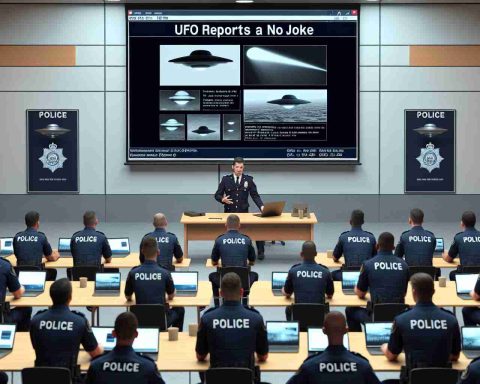The Mysterious Twinkle of Sirius: A Closer Look
The night sky often mesmerizes with its spectacular sights, but one star in particular has captured the attention—and confusion—of stargazers everywhere. Known as Sirius, this celestial body dazzles with a distinct twinkle that leaves many wondering if it’s more than just a star.
Visible from the eastern horizon during winter evenings, Sirius stands out not only for its brightness but also for its flickering appearance. This phenomenon, scientifically termed scintillation, is caused by the Earth’s atmosphere disrupting the light from the star, making it seem to glow in various colors. Situated low in the sky, its light travels through more turbulent air, enhancing its shimmering effect.
Interestingly, sightings of Sirius have been misinterpreted as UFOs. In 2022 alone, there were multiple reports of unidentified flying objects linked to this brilliant star, leading experts to explore why individuals mistake it for something more mysterious. They noted that shaky smartphone recordings amplify the illusion of intricate structures and hues around Sirius.
For those curious about identifying celestial bodies, experts recommend using astronomy apps that can easily name the objects you see. Sirius is one of many heavenly entities that can spark the imagination, but with a little knowledge, you can distinguish between a star, a planet, or even a passing aircraft. As the mysteries of the night sky unfold, simply looking up can lead to astonishing discoveries.
The Cultural and Economic Echoes of Sirius
The allure of Sirius transcends mere astronomical fascination; its impact reverberates through various facets of society and culture. Historically, this luminary held a pivotal role in ancient civilizations, influencing calendars, agricultural practices, and navigation. The Egyptians revered Sirius as a harbinger of the annual flooding of the Nile, which was crucial for their agrarian society. Today, such ties to celestial bodies can foster a sense of connection to our shared history and collective human experience.
As interest in astronomy surges with the advent of technology and social media, the ongoing fascination with stars like Sirius may energize the global economy. The popularity of stargazing elevates industries such as tourism, education, and technology. In recent years, businesses have emerged that offer stargazing experiences, selling everything from telescopes to guided stargazing tours in remote locations. According to industry reports, the global stargazing market is projected to grow significantly, as enthusiasts seek deeper connections with the cosmos.
Furthermore, the environmental aspects of stargazing merit consideration. The shift toward urbanization has led to light pollution, obscuring stellar visibility. Raising awareness about Sirius and other celestial wonders can invigorate conservation efforts aimed at preserving dark skies, which are vital for both ecological balance and human enjoyment of the universe.
In contemplating the long-term significance of Sirius, we find reflections of human curiosity and the potential for cultural cohesion. As we continue to look skyward, embracing both modern technology and ancient wisdom, the mysteries of stars like Sirius remind us of our place in the universe.
Unlock the Mysteries of the Night Sky: Why Sirius Stands Out
Exploring the Phenomenon of Sirius
Sirius, often referred to as the “Dog Star,” is the brightest star in the night sky and a prominent fixture in the constellation Canis Major. Its brilliance, particularly in winter months, draws both casual observers and seasoned astronomers alike. What makes Sirius truly captivating is not just its luminosity, but its unique twinkling, also known as scintillation, which can leave stargazers in awe.
Understanding Scintillation: The Science Behind the Twinkle
Scintillation occurs when starlight passes through the Earth’s atmosphere, where varying layers of temperature and density distort the light. This effect is particularly pronounced when stars like Sirius are low on the horizon, as their light travels through a larger volume of atmosphere, encountering more turbulence. Consequently, the light from Sirius can appear to change colors and intensity, creating the illusion of a shimmering star.
Use Cases for Stargazers
For astronomy enthusiasts and beginners alike, learning to identify Sirius can enhance stargazing experiences. Here are some effective strategies:
1. Use Astronomy Apps: Applications such as SkyMap or Star Walk can help identify Sirius and other celestial bodies quickly by pointing your device to the sky.
2. Check Seasonal Positions: Sirius is best visible from the northern hemisphere during winter months, appearing in the southern sky. Familiarizing yourself with its annual position can help in locating it.
3. Join Local Astronomy Clubs: Participating in local stargazing events can enrich your understanding of celestial phenomena, including discussions about Sirius.
Pros and Cons of Stargazing
# Pros:
– Educational: Observing stars like Sirius provides insight into astronomy and the structure of our universe.
– Relaxation: Stargazing can be a peaceful way to unwind, away from the hustle of daily life.
– Social Activity: It can foster community when done in groups or at organized events.
# Cons:
– Weather Dependent: Cloudy or inclement weather can hinder visibility.
– Light Pollution: Urban areas often suffer from excessive artificial light, making it difficult to see stars like Sirius clearly.
– Misinterpretations: As noted, bright stars can be misidentified as UFOs, leading to confusion among novice observers.
Security and Sustainability in Stargazing
With increasing interest in astronomy, concerns regarding light pollution have emerged. Efforts to mitigate this include:
– Advocating for Dark Skies: Campaigns aimed at reducing artificial outdoor lighting help preserve the natural night sky.
– Using Eco-friendly Equipment: Opting for solar-powered telescopes or gadgets can minimize environmental impact while exploring the heavens.
Looking Forward: Trends in Astronomy
As technologies evolve, the future of stargazing is likely to become even more accessible. Innovations like augmented reality in astronomy apps provide users with interactive experiences, allowing them to visualize constellations and celestial events in real-time. Moreover, as communities grow more environmentally conscious, there will be a push for sustainable practices in astronomy, ensuring that everyone can enjoy the night sky for generations to come.
For further exploration into the wonders of the universe, including additional insights about Sirius and other celestial bodies, visit NASA.




















